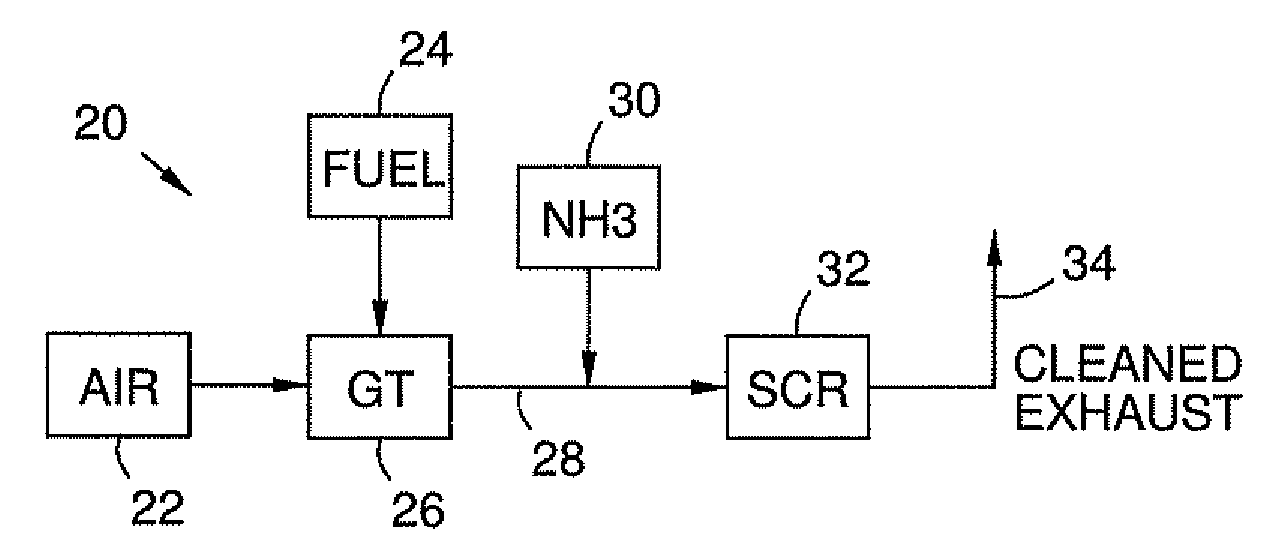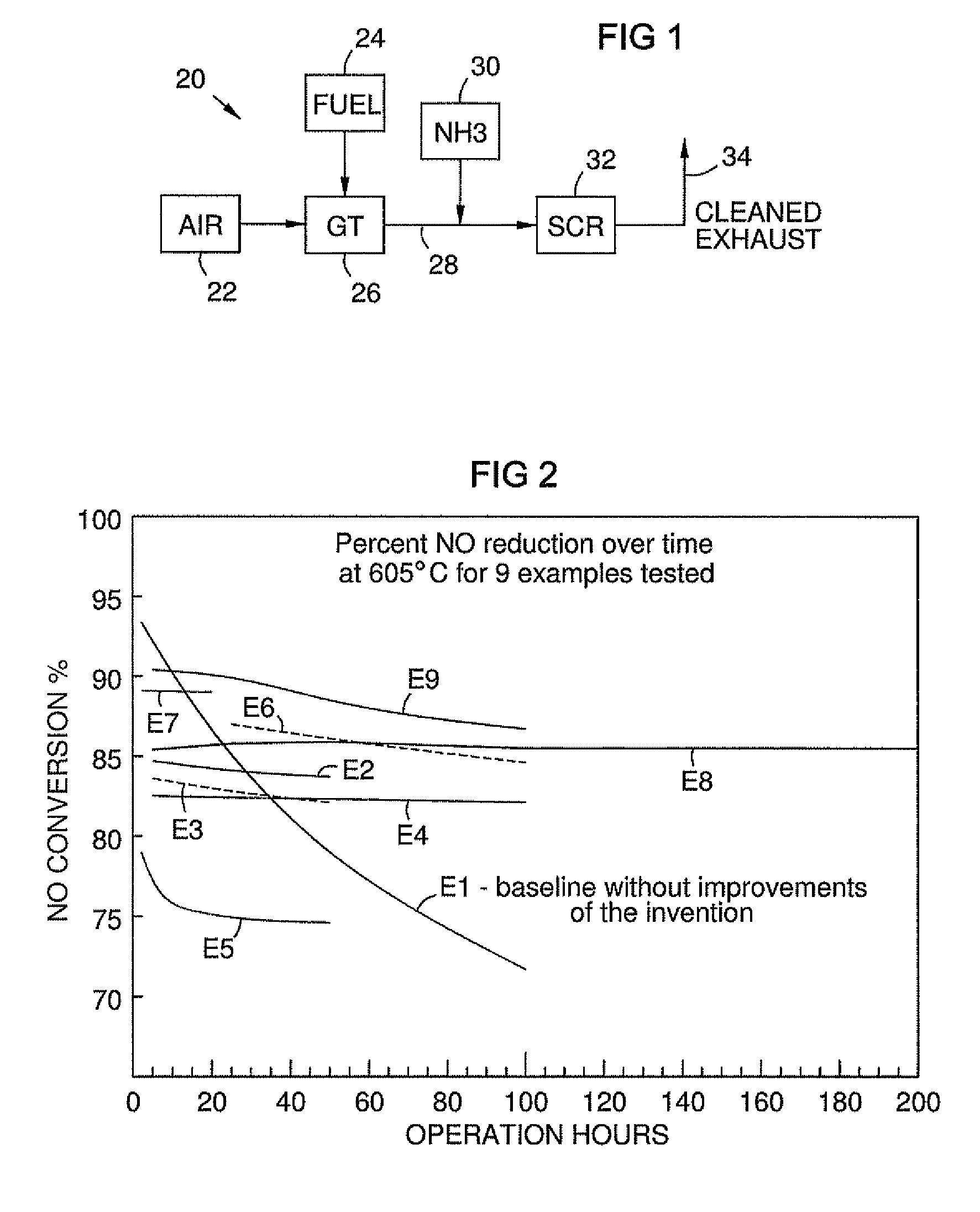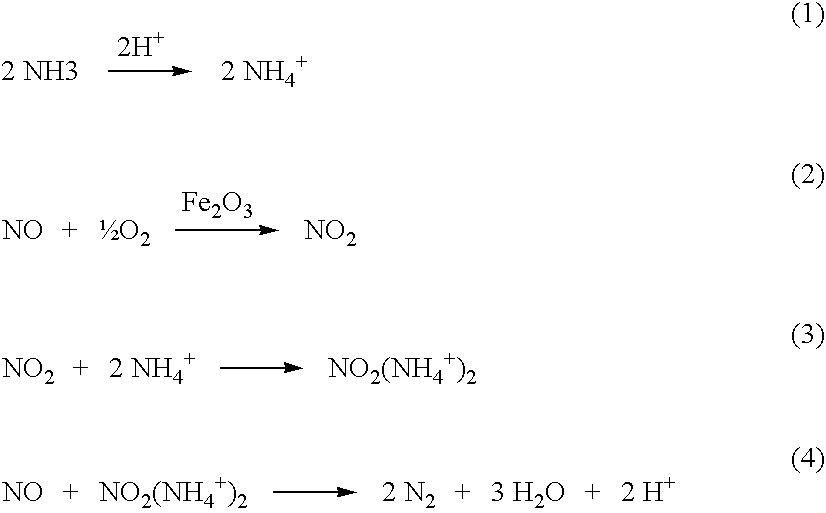High temperature catalyst and process for selective catalytic reduction of NOx in exhaust gases of fossil fuel combustion
a high-temperature catalyst and catalyst technology, applied in the direction of catalyst activation/preparation, physical/chemical process catalyst, separation process, etc., can solve the problems of tiosub>2/sub>scr, inapplicability, and inability to reduce nox
- Summary
- Abstract
- Description
- Claims
- Application Information
AI Technical Summary
Benefits of technology
Problems solved by technology
Method used
Image
Examples
example 1
Baseline Zeolite Beta with Fe, No Steam, Minor Calcination
[0034]Baseline iron-containing zeolite beta was prepared by adding 15 g of calcined zeolite beta to a 100 ml beaker. To the beaker was added 60 ml of distilled (DI) water, 15 g of zirconium acetate solution (20% ZrO2 by weight) and 0.109 g iron (III) nitrate nonahydrate (13.8 wt % iron). The resulting solution was mixed to form a slurry containing 0.001 parts iron per part zeolite beta. The slurry was used to washcoat a piece of monolith having a cell density of 230 cells / in2 and a volume of 21.4 cm3. Following washcoating, the monolith was dried, then calcined at 525° C. for 1 hour. The baseline catalyst described above was evaluated for its ability to decompose NO using NH3. The baseline catalyst was evaluated at 605° C. at a space velocity of 20,000 hr−1 employing a feed stream consisting of 10% O2, 6.8% H2O, 50 ppm NO, 60 ppm NH3, balance N2. The table below reports the conversion of NO and the effluent concentration of N...
example 2
Zeolite Beta with 0.6% Fe, Steam, Calcination, Fe Addition
[0036]18 g of calcined zeolite beta was exposed to 15% H2O / Air at 525° C. for 5 hours then calcined at 825° C. for 2 hours in dry air. The resulting zeolite powder was used to prepare a monolithic catalyst. 17.6 g of the above zeolite was added to a 100 ml beaker. To the beaker was added 50 ml DI water, and 0.764 g iron (III) nitrate nonahydrate (13.8 wt % iron). Following 1 hour, 17.6 g of zirconium acetate solution was added to the slurry and then mixed. (20% ZrO2 by weight). The slurry was used to washcoat a piece of monolith having a cell density of 230 cells / in2 and a volume of 26.2 cm3. Following washcoating, the monolith was dried, then calcined at 525° C. for 1 hour. The catalyst described above was evaluated for its ability to decompose NO using NH3. The catalyst was evaluated at 605° C. at a space velocity of 20,000 hr−1 employing a feed stream consisting of 10% O2, 6.8% H2O, 50 ppm NO, 70 ppm NH3, balance N2. The t...
example 3
Zeolite Beta with 0.6% Fe Prepared by Fe Addition, Steam, Calcination
[0038]25 g of calcined zeolite beta was added to a 200 ml beaker. To the beaker was added 50 ml of DI water and the slurry was stirred. To the resulting slurry was added 1.0853 g iron (III) nitrate nonahydrate (13.8 wt % iron). The slurry was then heated to 90° C. Following 3 hours, the slurry was removed and filtered. Resulting material was washed with DI water and filtered again. Dried material was exposed to 15% H2O / Air at 525° C. for 5 hours, and then calcined at 825° C. for 2 hours in dry air. Following steam treatment, the material was brown in color. Following high temperature calcinations, the material turned white.
[0039]The resulting material powder was used to prepare a monolithic catalyst. 20.0 g of the above zeolite was added to a 100 ml beaker. To the beaker was added 65 ml DI water, and 20 g zirconium acetate solution (20% ZrO2 by weight). The resulting solution was mixed to form a slurry. The slurry ...
PUM
| Property | Measurement | Unit |
|---|---|---|
| temperature | aaaaa | aaaaa |
| temperatures | aaaaa | aaaaa |
| temperatures | aaaaa | aaaaa |
Abstract
Description
Claims
Application Information
 Login to View More
Login to View More - R&D
- Intellectual Property
- Life Sciences
- Materials
- Tech Scout
- Unparalleled Data Quality
- Higher Quality Content
- 60% Fewer Hallucinations
Browse by: Latest US Patents, China's latest patents, Technical Efficacy Thesaurus, Application Domain, Technology Topic, Popular Technical Reports.
© 2025 PatSnap. All rights reserved.Legal|Privacy policy|Modern Slavery Act Transparency Statement|Sitemap|About US| Contact US: help@patsnap.com



